| New Products |
|
|
| |
|
Tech Talk |
|
Bridging the 'Generation Gap'
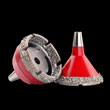
Generating cuts the back curve on a lens, on which the prescription is based. Basically, two operations are performed: the prescription parameters on the back side of the lenses are created and the excess lens material is removed. The chance for spoilage is greater at this stage then at any other stage of surfacing.
A number of problems can result in a "generation gap.?Lenses can be cut too thin and break, be chipped, or can be cut unevenly. Warpage, waves, too much prism or off-powers due to poor curves being cut by the generator can also occur.
To close the gap, it's important to calibrate generators on a regular schedule, according to manufacturer specifications. The generator wheel on newer equipment, the cutting blade, which performs the actual cutting of the lens, is the critical component of the generator. Most lens errors caused at the generator are due to the lens being cut improperly, indicating a problem with calibration of the wheel or blade.
The wheels, which are embedded with diamonds, eventually get dull, or gunked up with lens swarf, particularly when cutting a variety of different materials. A dull or dirty wheel can generate too much heat, which will warp the lenses. Too much heat will also cause waves in the lens. It will also cut unevenly, and that can cause too much prism.
In extreme cases, a dull wheel will chip the lens. Cutting the lens too thin can be a problem with a dull wheel, but it also can be caused by a machine that is not calibrated properly. Similar problems will occur on newer three-axis generators which use a blade instead of a wheel. They require different cleaning and maintenance protocols, and manufacturer guidelines must be followed. With older generators, where the operator manually set the machine, the settings can be off, which mainly causes either an off-power, or a lenses being cut too thin. These calculations are mostly performed by software systems today. If a lens is off-power or too thin and other reasons are eliminated, a software problem is then indicated.
In addition, many generators today cut all lens materials, often requiring only a wheel or blade change for polycarbonate. In order to take full advantage of this new efficiency, cleaning the generator is more important than ever. Particles and debris can also accumulate in the generator if the general area around the equipment is not kept clean.
Higher volume labs also prefer to dedicate one generator to polycarbonate to avoid problems with debris. Generator water must be filtered and re-circulated to avoid build up of debris and sustain quality of the cutting wheel or blade. Change filters as needed. Some newer generators feature cribbing, which cuts the lens down so edging is more efficient. However, precise and accurate frame and PD measurements are required for cribbing, and if these figures are off, cribbing can result in spoilage.
|
| | |
 |
|
Taxes, the Hidden Time Bomb—Part Two
 Independently owned optical laboratories often represent the primary asset of their owners. Accordingly, owners may be unnecessarily exposed to unforeseen taxation in the areas of estate planning, family transfers and the changing tax climate. Lab owners should divide their goals into three categories: short term, medium range and long term. Each of these planning periods carry different taxation factors, which if not addressed well in advance, may significantly affect the ability of owners to realize their objectives. Independently owned optical laboratories often represent the primary asset of their owners. Accordingly, owners may be unnecessarily exposed to unforeseen taxation in the areas of estate planning, family transfers and the changing tax climate. Lab owners should divide their goals into three categories: short term, medium range and long term. Each of these planning periods carry different taxation factors, which if not addressed well in advance, may significantly affect the ability of owners to realize their objectives.
The reality of the business is that all lab owners, regardless of age or geographic location, should set up a transition plan coupled with an associated time frame to implement each phase of the plan. Some may consider transfers of ownership to family members or key employees while others should look at outside participation in ownership. This may not necessitate action in the near term, but rather a goal associated with knowing or using the best information available to tie in all of the business and taxation factors to the plan. Whichever plan fits the needs of the lab owners, estate taxes, gift taxes and the taxation on the gains received on a transfer are important factors.
Taxation rates and concessions implemented during the current administration are limited in life. A change of administration coupled with a change in the control of Congress may further expedite the need to give near term attention to planning procedures. The current tax relief in the areas of lower income taxes, a 15 percent Federal long-term capital gains tax and favorable estate tax relief are all scheduled to expire. Accordingly, the years 2007 and 2008 may be critical tax planning years for corporate, individual, long term capital gain, alternative minimum preference, and Federal estate tax rates and treatment.
A solid business plan should include either a Certified Public Accountant familiar with tax planning and or an attorney specializing in taxation and estate planning. The plan should encompass a review of the position and needs of all of the owners, all associated assets of their estates and a complete understanding of their business, its valuation and the needs of their participating family members.
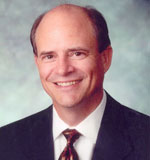 —Thomas F. Puckett is managing director and CEO of the San Diego based investment banking firm HPC Puckett & Company, which specializes in mergers and acquisitions of wholesale optical laboratories. Puckett can be reached via email at
[email protected]. For more information about the company, go to their Web site at
www.hpcpuckett.com. —Thomas F. Puckett is managing director and CEO of the San Diego based investment banking firm HPC Puckett & Company, which specializes in mergers and acquisitions of wholesale optical laboratories. Puckett can be reached via email at
[email protected]. For more information about the company, go to their Web site at
www.hpcpuckett.com.
|
|
|
| |
|
 |
|
The 'Rite' Solution to a Slippery Problem
 When the new super-slick hydrophobic coatings hit the industry, many laboratories experienced a jump in breakage numbers due to block slippage during the edging process. At Rite-Style Optical (Omaha, Neb.) we tried several pads on the market-some with more success than others-but still ended up re-fabricating and re-coating too many lenses. When the new super-slick hydrophobic coatings hit the industry, many laboratories experienced a jump in breakage numbers due to block slippage during the edging process. At Rite-Style Optical (Omaha, Neb.) we tried several pads on the market-some with more success than others-but still ended up re-fabricating and re-coating too many lenses.
Butch Clark, finish lab manager, describes how Rite-Style Optical found a solution. "In our lab, we now AR coat the lenses, then send them to be edged. After edging we go back and add the slick hydrophobic coating." He went on to explain, " Although this requires extra handling of the lenses, it still takes less time than remaking the breakages due to slipping-not to mention the cost of re-fabrication."
For uncut jobs, Clark recommends cleaning the lens with isopropyl alcohol first, then applying a transparent Riki pad, made by Miki Sangyo (pictured above), under the regular blocking pad. Lenses should be edged as soon as possible after blocking them. The pads and blocks tend to lose adhesion the longer they sit. Clark also suggested that high Rx's and thicker lens blanks, should be run 10-over, and then reblock to finish the edging. These steps have significantly reduced the problems Rite-Style technicians were having with the new, slippery coatings.
Second Opinions
"We really wrestled with these lenses and tried many different applications as well," said Ronnie Phillips, president of National Optical in Monroe, La. "But now we use a new pad, HydroEdge from DAC Vision. It's an aggressive blocking pad. Used together with solid blocks with no recess, it solves the problem.
Phillips explained that when his lab processes the super slick oleophobic coated lenses, the lab technicians will apply a transparent Riki pad [from Miki Sanyo] under the HydroEdge pad when processing. The lenses are edged after both AR coating and hydrophobic or oleophobic coatings are applied.
"We add a special adhesion layer in the chamber as the last 'coating,' said Dave Cuffe, director of technical support for Essilor Laboratories of America, explaining how Essilor has used its coating process to solve slipping problems during edging. "This slightly bluish layer prevents the blocks from slipping and washes off after the lens is edged."
How does your lab edge hydrophobic coated lenses? Let Lab Advisor know by emailing us at
[email protected]. |
 |
| |
 |
|
Kim Scheidler, Director of Education for Sutherlin Optical
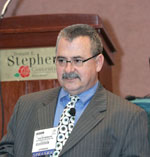 Kim Scheidler, ABOC, FOAA, WLO refers to himself as the World's Laziest Optician (WLO). "I hate doing anything twice," explained Scheidler. "If I can find a way to prevent things from going wrong, I will learn it, teach it, write about it, and talk about it, just to save 10 minutes and do it right the first time." Kim Scheidler, ABOC, FOAA, WLO refers to himself as the World's Laziest Optician (WLO). "I hate doing anything twice," explained Scheidler. "If I can find a way to prevent things from going wrong, I will learn it, teach it, write about it, and talk about it, just to save 10 minutes and do it right the first time."
Scheidler, an industry veteran of 30 years, 16 with Sutherlin Optical, explained that his favorite part of the day is seeing "gotchas!" (That wonderful look in someone's eyes when they really understand and he had a part in that.) "I love my job and the work I am able to do," he added. "There is fantastic young talent out there and I get to work with them."
Running doctor's offices in his early years and then selling for laboratories, he explains that his lucky break came when Steve Sutherlin fired him as a sales rep after three years and gave his job to someone else. It was then that Sutherlin University was created. Sutherlin U. offers classes for their customers in everything from the basic optics course to the step by step of lens processing. He even offers ABO prep classes and refresher optics.
Many doctor's offices will spend a day with Scheidler at Sutherlin U. to learn about new lenses, new materials, new processing techniques such as free form lenses, and how to sell and promote these and many other products. "We have a lot of repeat attendees who get an update every year," he commented. "I want our customers to be able to use what they learn to grow their own businesses and be successful."
Scheidler is also responsible for Sutherlin's award winning Web site,
www.sutherlinoptical.com.
Adapting the same philosophy of prevention and customer focus; he wanted a site that was friendly, easy to navigate, and had up to the minute information. "I get a kick out of working on the Web site," Scheidler explained. "I wanted more interaction between our customers and their patients by offering valuable information and services for both." With the ability to check pricing, lens availability, and new product information, eyecare professionals can quickly share information with their patients as well as use the information as selling tools. Consumers can look up eyecare professionals and their addresses, product information, and ask questions about eyewear. He continues to add to the Web site every month, and continues to seek feedback from users.
"I am really glad I got fired from sales," he added. 'I love the optical industry, all the changes, the technology, and the people make my job fun. Though I miss going out on the road sometimes." Scheidler does take to the road sometimes, he is often an industry speaker at the Heart of America conferences or the Midwest Optical Laboratories Association meetings.
--Linda Little
, contributing editor
Linda
Little
is an optical industry veteran and writer who specializes in laboratory and technical topics. She can be reached at 214-215-5453, or at
[email protected].
|
 |
| |
 |
|
Toledo Optical Puts the Breaks on Breakage
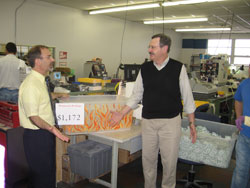 |
| Bob Lommerse (left), general manager of Toledo Optical, reviews the lab’s daily breakage count with operations manager Dennis Snell. While employees watched, they calculated the value of the previous day’s breakage. |
Toledo Optical struggles, as most laboratories do, with keeping its breakage low. After experiencing a relatively high level of breakage over the course of several months, the Toledo, Ohio-based lab implemented a unique process by which they could increase awareness and decrease laboratory breakage. During the month of October 2006, Toledo Optical introduced "Breakage Awareness Month."
"This internal program was kicked off with a company-wide luncheon explaining the need to decrease breakage and the overall impact it has for our laboratory in the future," explained sales manager Jeff Szymanski. "We implemented a daily morning update over our PA system, updating the entire laboratory on the previous day's stats, as well as offering encouragement for that day. During the month, we brought in an ice cream machine to make sundaes for all of our employees, inspiring them to "lick" the breakage. We created daily badges for all employees to wear, offering a different and unique inspirational message everyday."
The highlight of the program was when the lab management brought in and displayed a wheelbarrow full of play money equal to the average amount of money lost in breakage per month over the previous several months. The wheelbarrow was accompanied by another container which had flames painted on the outside and was chockfull of dry ice. "The smoke, flames and overflowing cash made for a visual which was hard to beat," Szymanski recalled. "During the course of this month, we transferred the previous day's breakage amount in this play cash from the good side to the "burned up" side. The end result for our employees was that they would be able to keep and divvy up all the monies left over on the good side at the end of the month.
While breakage continues to be a challenge and an expensive nuisance that Toledo experiences daily, Breakage Awareness Month was successful in increasing awareness of breakage and its impact on the laboratory. "We were successful in changing the behavior of many of our employees, while creating a more positive atmosphere within our laboratory," Szymanski concluded. |
| |
 |
|
Hoya Vision Care Acquires Volunteer Optical—Hoya Vision Care, North America has acquired Volunteer Optical, a full service prescription laboratory located in Knoxville, Tenn. The purchase price was not disclosed. Volunteer Optical was founded in 1983 by J.B. Morgan. It generated gross sales of approximately $2.7 million in 2006, according to Hoya. The lab has 26 employees and derives sales from customers primarily in Tennessee and Kentucky. "Volunteer has an energetic team of exceptionally talented people including past OLA president Susan Crawley, Sandra Morgan, and Jeff Morgan," said Barney Dougher, president and chief executive officer of Hoya Vision Care, North America. "We are thrilled that this talented team will continue to advance and grow with us and will further strengthen Hoya's position in Tennessee and Kentucky." Tom Puckett and Jason Meyer of HPC Puckett and Co. were instrumental in brokering the deal between Volunteer Optical and Hoya Vision Care. |
| |
|
Diversified Acquires Gas Permeable Suppliers—Diversified Ophthalmics, based in Cincinnati, has acquired Aero Contact Lens of Ohio in a private transaction with owner Bob Lawner. Aero, based in Dayton, Ohio is supplier of gas permeable contact lenses with a nationwide customer base. It was founded by Lawner in 1999. The sale includes Aero's proprietary lens designs and products which will continue to be available through D-Con, Diversified's gas permeable contact lens division, according to Dr. Ronald F. Cooke, OD, president and CEO of Diversified Ophthalmics, an ophthalmic products and services company based here.
Lawner will be joining Diversified in the capacity of a fitting consultant and gas perm design specialist.
The acquisition of Aero follows Diversified's recent purchase of Platt Contact Lens Service, an independent, wholesale manufacturer of custom-made RGP contact lenses located in Mt. Vernon, Ohio. |
| |
|
Essilor to Offer Digital Surfacing to Independent Labs—Essilor of America is introducing a new program called the Digital Surfacing Extended Offering (DEO) that for the first time will allow independent labs to produce Essilor progressive lenses using the company's proprietary digital surfacing technology. Speaking at a press conference at last month's International Vision Expo East, Bob Colucci, head of Essilor's Independent Distribution Division (IDD) said that beginning May 1, Essilor will launch a beta test of the DEO, which he described as "a turnkey program covering patents, brands, technology and processes." According to Colucci, Essilor will initially offer the labs its Varilux Physio 360?PAL in all materials except 1.74-index plastic. Essilor will add its new Varilux Ellipse 360?later in the second quarter, with an "optimized" version of Varilux Comfort to follow in the fourth quarter. |
| |
|
|
| Pictured above at the award ceremony are, left to right, Mike and Steve Sutherlin, Dr. Norman Hinkle, OD, president of HOACLS and John Sutherlin. |
HOACLS Honors Sutherlin Optical—The Heart of America Contact Lens Society (HOACLS) recently presented its annual Vision Service Award to Sutherlin Optical of Kansas City, Mo. The award is presented annually to an individual or group who exhibits extraordinary dedication and untiring service to the profession of optometry. |
| |
|
Vision-Ease Lens Awards FEA Industries 'Select Lab of the Year 2006'—Last month at International Vision Expo East in New York, Vision-Ease Lens executives presented the company's 2006 Select Lab of the Year award to FEA Industries, a full-service lab located in Morton, Pa. Pictured at the award presentation are, left to right: Pete Smith, key account manager, Vision-Ease Lens; Michael Ness, vice president of sales and marketing, Vision-Ease Lens; and Bill Heffner, owner and chief executive officer, FEA Industries. | |
 |
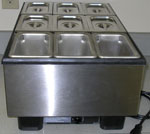 |
Optical Chemicals 9-Pan Tint Machine
Optical Chemicals' new high performance nine-pan tint machine features a dome-heating element cast into the base of an insulated tank to eliminate leaking. According to the manufacturers, the unit uses 25 percent less energy than competing products and is coated with a non-stick surface which prevents scale and corrosion. Heat transfer fluid is recommended, but the tint machine will work with water. It is UL- and CE-listed and made in the USA. International receptacles are available at no additional cost. Optical Chemicals offers a one-year replacement warranty. The unit measures 19 inches long by 12 inches wide by 6 high, and has a six-foot power cord.
(866) 613-3247
www.opticalchemcials.com |
| |
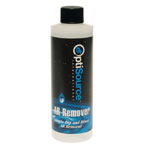 |
OptiSource International AR Removal Kit
OptiSource International's AR removal chemical now features an improved formula that removes AR coatings from plastic lenses in about 10 seconds, rather than over 10 minutes. Lenses are dipped into the room temperature solution for 10 seconds and removed. Virtually any AR coatings will be removed and patient's glasses can be returned as they wait. The AR Removal Kit includes: an eight-ounce bottle of removal chemical, a plastic basin, lens tongs, chemical resistant gloves and goggles.
(800) OptiSource (678-4768)
www.1-800-optisource.com |
| |
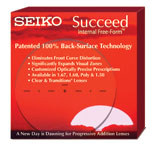 |
Seiko Succeed Internal Free-Form PAL
Seiko Optical Products of America is expanding its portfolio of progressive addition lenses (PALs) with the release of the Seiko Succeed Internal Free-Form, a digitally surfaced progressive that features a 100 percent back-surface design. The patient's entire Rx is placed onto the back surface of the lens, leaving the front surface a perfect sphere. This alleviates the 'swim and sway' effect caused when the progressive power is on the front surface and effectively eliminates non-adapts, according to Seiko. It also significantly expands the fields of view, since the corrective surface is placed closer to the eye.
Aspheric compensation is calculated for each sphere, cylinder, axis and prism in each visual field, taking into account eye rotation and the change in vertex distance. This allows for total management of off-center astigmatism and power error, another cause of non-adapts.
The Succeed Internal Free-Form is being distributed through select U.S. wholesale laboratories equipped with digital or direct surfacing technology to process the lens. A variety of materials and coatings are available, including 1.67, poly and plastic, and Transitions lenses. A polarized version of the lens will be available in standard plastic and 1.67 beginning in May.
(800) 235-5367
http://www.seikoeyewear.com |
| |
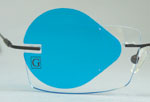 |
Venture Tape Notched Slip-Stop Guards
Venture Tape is introducing notched Slip-Stop Guards. The new Slip-Stop Guards look the same as the originals but have notches on each side for easy application and removal from rimless lenses. This allows lab processing personnel to handle all or most of the lens while working on it and to come in closer contact with the edge of the lens. The notched version helps prevent scratching on the front and back of the lenses caused by adjusting and mounting tools that are used for drilled rimless frames.
The notched Slip Stop Guards are available in blue and come in rolls of 1,000 and 2,000.
(800) 343-1076
www.venturetape.com
|
| |
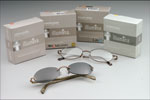 |
Vision-Ease LifeRx Outlook/Illumina LifeRx/Illumina SunRx
Vision-Ease Lens is releasing its LifeRx photochromic lenses in its Outlook progressive design. In addition, the company has extended the add powers of its Illumina LifeRx photochromic progressive and Illumina SunRx polarized progressive polycarbonate lenses to make the range +0.75 to +3.50D.
Outlook LifeRx polycarbonate PALs are available in gray and brown in 1.50, 3.50, 5.00 and 6.50 base curves, with a +6.25 to -9.00D prescription range and +0.75 to +3.50 adds. A 7.50 base curve is also being developed and will be added soon, Vision-Ease reports.
Illumina offers an ultra-wide reading area and exceptional softness, while optimizing viewing at all distances. Illumina lenses are available in 1.50, 3.00, 4.50 and 6.00 base curves with a +6.50 to -10.00D prescription range. A 7.25 base curve will also be available soon.
(800) 328-3449
www.vision-ease.com
|
| | |
| | |
In this edition...
 |
DOLLARS & SENSE |
| Taxes, The Hidden Time Bomb. Part Two |
 |
THE RX FILES |
| The 'Rite' Solution to a Slippery Problem |
 |
FOCUS ON… |
| Kim Scheidler, Sutherlin Optical |
 |
NEWS TO USE |
| Toledo Optical Puts the Breaks on Breakage |
 |
LAB NOTES |
Hoya Vision Care Acquires Volunteer Optical
Diversified Acquires Gas Permeable Suppliers
Essilor to Offer Digital Surfacing to Independent Labs
HOACLS Honors Sutherlin Optical
Vision-Ease Lens Awards FEA Industries 'Select Lab of the Year 2006' |
 |
TECH TALK |
| Bridging the 'Generation Gap' |
 |
IT ZONE |
| DVI Receives Patent and Trademark for RxWizard | |
| |
|
•
Subscribe to Lab Advisor
The monthly update for Optical Laboratory Owners and Managers
•
Forward this issue of Lab Advisor to a friend or colleague
•
Print this issue of Lab Advisor
•
Stay on top of optical industry news!
Subscribe to our other
e-newsletters:
•
VMail Extra
•
Business Essentials
If you have lab news or want to share information about technical topics, please
contact us.
Or
contact
Andrew Karp,
Editor-in-Chief
Visit
LabTalkonline.com for additional articles of interest about labs. |
| |
|
|
| |
|
IT Zone |
|
DVI Receives Patent and Trademark for RxWizard
Digital Vision, Inc. (DVI), based in Portland, Ore., has been granted a U.S. patent for the computer software technology involved in the Internet access software RxWizard, U.S. Patent No. 7188082. Trademark recognition for RxWizard has also been granted.
The RxWizard helps ECPs maximize their utilization of the Internet to send prescriptions and stock orders to labs and check on the status of their work 24-hours a day. Using the RxWizard "Cascading Windows?technology, which guides the ECP to the correct order, is integral not only to the ease of use of the software, but the accuracy of the order. This accuracy helps the lab make the prescription with fewer calls back to the ECP, and speeds the turnaround time, according to DVI.
"We are very proud of our team approach to software development, and have many talented people who have been integral in advancing this technology,?said Gordon Keane, president of Digital Vision. "Knowledge of the optical industry, combined with inventive approaches to solving problems, is one of DVI's strengths. This patent is testimony to very exacting work."
|
| | |
